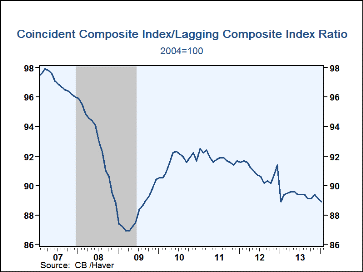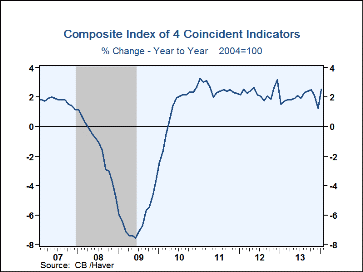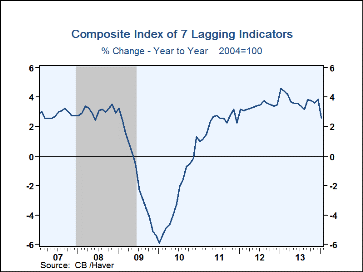 Global| Feb 20 2014
Global| Feb 20 2014U.S. Leading Economic Indicators Continue to Improve
by:Tom Moeller
|in:Economy in Brief
Summary
The index of Leading Economic Indicators, published by the Conference Board, increased 0.3% (5.0% y/y) in January following no change in December, revised from up 0.1%. A 0.4% rise was expected in the Action Economics Forecast Survey. [...]
The index of Leading Economic Indicators, published by the Conference Board, increased 0.3% (5.0% y/y) in January following no change in December, revised from up 0.1%. A 0.4% rise was expected in the Action Economics Forecast Survey. The breadth of component increase bounced back to 60% last month. A steeper interest rate yield curve, fewer initial claims for unemployment insurance and an improved leading credit index worked to raise the leading index. Moving it lower were fewer building permits, a shorter workweek and a lower ISM new orders index.
Countering this message of improvement was a decline in the ratio of coincident-to-lagging indicators. It's another leading indicator and fell to nearly its lowest level of the economic recovery. It measures how the economy is performing versus its excesses.
The index of coincident indicators ticked up 0.1% (2.6% y/y), the same as during December. Last month, payroll employment, personal income less transfers and manufacturing & trade sales made positive contributions to the overall index but industrial production fell.
The index of lagging economic indicators improved 0.3% last month (2.6% y/y) following a 0.4% December rise. A longer duration of unemployment and a higher ratio of consumer installment credit-to-personal income had the largest positive impacts of the index.
The Conference Board figures are available in Haver's BCI database; the components are available there, and most are also in USECON. The forecast figures for the Consensus are in the AS1REPNA database. Visit the Conference Board's site for coverage of leading indicator series from around the world.
| Business Cycle Indicators (%) | Jan | Dec | Nov | Y/Y | 2013 | 2012 | 2011 |
|---|---|---|---|---|---|---|---|
| Leading | 0.3 | 0.0 | 0.9 | 5.0 | 3.4 | 2.2 | 5.3 |
| Coincident | 0.1 | 0.1 | 0.4 | 2.6 | 2.0 | 2.3 | 2.6 |
| Lagging | 0.3 | 0.4 | 0.0 | 2.6 | 3.8 | 3.4 | 2.3 |
Tom Moeller
AuthorMore in Author Profile »Prior to joining Haver Analytics in 2000, Mr. Moeller worked as the Economist at Chancellor Capital Management from 1985 to 1999. There, he developed comprehensive economic forecasts and interpreted economic data for equity and fixed income portfolio managers. Also at Chancellor, Mr. Moeller worked as an equity analyst and was responsible for researching and rating companies in the economically sensitive automobile and housing industries for investment in Chancellor’s equity portfolio. Prior to joining Chancellor, Mr. Moeller was an Economist at Citibank from 1979 to 1984. He also analyzed pricing behavior in the metals industry for the Council on Wage and Price Stability in Washington, D.C. In 1999, Mr. Moeller received the award for most accurate forecast from the Forecasters' Club of New York. From 1990 to 1992 he was President of the New York Association for Business Economists. Mr. Moeller earned an M.B.A. in Finance from Fordham University, where he graduated in 1987. He holds a Bachelor of Arts in Economics from George Washington University.










